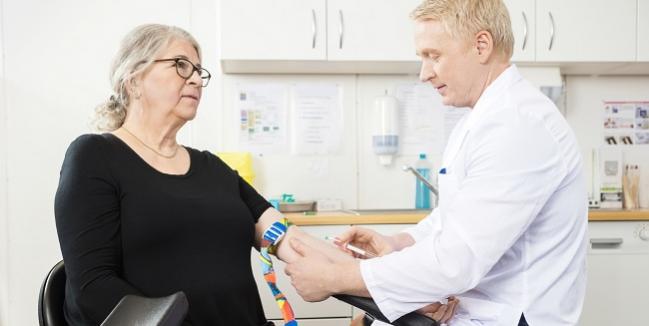Counting CPCs May Beat Stress Tests for Stratifying CAD Risk
The information from these measurements “may be more useful to cardiologists” than treadmill exercise tests, one author says.

Measuring the number of circulating progenitor cells (CPCs) in the blood before and after a stress test may be a better way of assessing ischemia and risk in CAD patients compared with today’s standard nuclear imaging, which can be expensive and expose patients to harmful radiation, suggest the results of a new study.
Along with stem cells, CPCs are released from the bone marrow to circulate throughout the body to repair and regenerate blood vessels and are especially active during exercise.
“Our study highlights the potential significance of measuring CPC counts during stress testing as a novel method of stratifying risk in patients with known CAD,” write lead author Kasra Moazzami, MD (Emory University School of Medicine, Atlanta, GA), and colleagues. “Although stress [single-photo emission computerized tomography (SPECT)] imaging for the detection of ischemic defects has been considered a valuable tool,” they say, “our results suggest that measuring the change in CPC counts may improve the discrimination of future risk of cardiovascular events compared with a standard clinical model that includes stress testing alone.
For senior author Arshed A. Quyyumi, MD (Emory University School of Medicine, Atlanta, GA), what was surprising about the results was just how good counting CPCs was, particularly compared with SPECT imaging. “It actually beat our standard testing in terms of being able to predict who's going to do better and worse over time,” he told TCTMD.
CPC Changes Inform
For the study, published online last week in JAMA Cardiology, the researchers prospectively recruited 454 patients with known CAD, including 31.3% who had stress-induced ischemia on SPECT, from Emory University-affiliated hospitals between June 2011 and August 2014. CPCs were measured using flow cytometry at rest and 45 minutes after treadmill stress testing.
Unsurprisingly, those with ischemia were more likely to report angina during exercise, but there were no significant differences observed between the groups with respect to heart rate, systolic blood pressure, or rate-pressure product at rest or during exercise.
While resting CPC counts were not different among those with and without stress-induced ischemia, the latter group saw a median decrease after exercise stress testing of 20.2% in their circulating CD34+/CXCR4+ cell counts, whereas the former had a median increase of 3.2% (P < 0.001 for both).
Over a median follow-up of 3 years, cardiovascular death and MI were each reported in 12 patients, bringing the total rate of adverse events to 5.2%. After adjustment for age, sex, race, smoking history, body mass index, history of heart failure, hypertension, dyslipidemia, and diabetes, the presence of stress-induced ischemia more than doubled the risk of adverse events (HR 2.79; 95% CI 1.55-5.03). On additional regression analysis, each 50% drop in baseline CD34+/CXCR4+ count was associated with an increase in adverse events (HR 1.48; 95% CI 1.23-2.95), but this association did not persist after stress-induced ischemia was included in the model.
Still, the change in CPC counts during exercise remained significantly associated with adverse events (HR 2.59; 95%CI 1.15-5.32 per 50% CD34+/CXCR4+ count decrease) even after adjustment for clinical variables and the presence of ischemia.
The researchers were better able to discriminate risk factors associated with incident adverse events when adding the change in CD34+/CXCR4+ counts to a model that included clinical characteristics, baseline CPC count, and ischemia (increase in C-statistic from 0.72 to 0.77; P = .003).
“A fall in CPC count after exercise appears to be an independent determinant of high risk in patients with stable coronary artery disease, even after adjusting for known clinical risk factors,” Moazzami said in a statement released by Emory. “The information gained from the changes in CPC counts during exercise may be more useful to cardiologists in risk stratifying these patients than the treadmill exercise test itself.”
In agreement, Quyyumi told TCTMD that “these tests aren't difficult to do. It could replace stress testing as a better way of judging who's at high risk and low risk . . . instead of doing all this imaging and things that we do. You just do a blood test before and after.”
He noted that the CPC test is not available for use at this time, but perhaps with replication of these results, this strategy could continue to show promise. “It's not easy to introduce new tests in medicine,” he said, adding that this method needs to also be made more “readily available” and not just performed by specialized hematological labs.
Yael L. Maxwell is Senior Medical Journalist for TCTMD and Section Editor of TCTMD's Fellows Forum. She served as the inaugural…
Read Full BioSources
Moazzami K, Lima BB, Hammadah M, et al. Association between change in circulating progenitor cells during exercise stress and risk of adverse cardiovascular events in patients with coronary artery disease.. JAMA Cardiol. 2019;Epub ahead of print.
Disclosures
- Moazzami and Quyyumi report no relevant conflicts of interest.


Comments